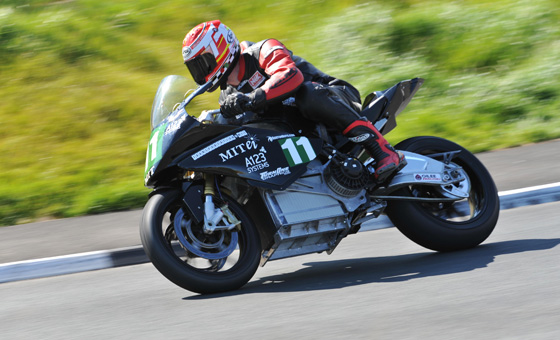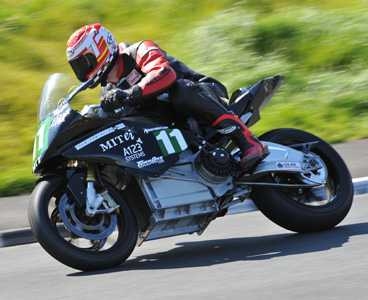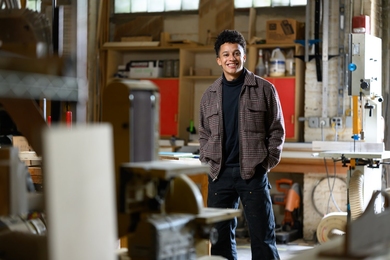
Rider Allan Brew takes the eSuperbike, an all-electric motorcycle developed at MIT, for a test drive during a qualifying round.
Photo: Susumu Sugitani
A group of MIT students led by PhD student Lennon Rodgers was among 32 teams who entered this year's all-electric race, bringing their custom-designed eSuperbike to the famous competition on the small island located between Ireland and Great Britain. Several practice and qualifying rounds whittled the field down throughout the two weeks leading up to the race; on Thursday afternoon (June 9) the team's motorcycle hummed across the finish line, coming in fourth with an average speed of 79 miles per hour.
"It was a great experience," Rodgers says. "I think the teams with the most reliable motorcycles were able to finish … we focused on reliability, and that's what saved us in the end."
Throughout the Isle of Man's 37.7-mile circuit, riders streak through villages and mountain passes at speeds of up to 180 miles per hour, navigating hundreds of kinks and bends in the road while trying to avoid obstacles including lampposts, phone booths, manhole covers and tram tracks. The racers zoom up and down mountain roads, summiting more than 2,000 feet above sea level before gunning down to the finish line.
Since the island's first race in 1907, gas-powered bikes have dominated the course, roaring to the finish in clouds of exhaust. In 2009, in an effort to green up the course, race officials opened the circuit to electric motorcycles with TT Zero — the island's first zero-emissions race. To spark competition, race coordinators put up a prize of £10,000 for the first electric bike to finish with an average speed of 100 miles per hour or more.
To date, the purse remains unclaimed, though entries have come close: This year's winner, MotoCzysz, missed the mark by a hair, with a record lap speed of 99.604 miles per hour. While this record lags the gas-powered best of slightly more than 130 miles per hour, it far outpaces most commercial electric bikes. Rodgers says competitive venues like the Isle of Man may yield the next generation of electric-vehicle design.
"This is where a lot of innovation comes in," Rodgers says. "And that's the thing about racing, is that it pushes you to try the extreme."
Rodgers remembers watching the very first TT Zero race two summers ago, while building an electric car in a machine shop at MIT. During breaks, he and students from MIT's Electric Vehicle Team watched the race over the Internet. It was then that they started kicking around the idea of building a high-performance electric motorcycle. The notion quickly morphed into a commitment, as the team set its sights on racing its final product on the Isle of Man.
The students first designed a model of the motorcycle using computer-assisted design (CAD), then enlisted the help of Yet-Ming Chiang, the Kyocera Professor of Ceramics in MIT's Department of Materials Science and Engineering. Chiang, co-founder of A123 Systems, a manufacturer of advanced batteries, offered to provide the team with four custom-designed lithium-ion batteries that, based on the team's CAD model, "fit like a glove," Rodgers says.
A challenge early on was figuring out how much juice would be needed to power the bike through the Isle of Man course. To find the answer, Rodgers mapped out GPS coordinates all along the route, estimating the amount of energy required to go up and down hills, around bends, and through straightaways at various speeds, accounting for places where braking might be necessary. After multiple calculations, he arrived at a figure of 11.88 kilowatt-hours of energy, a number that seemed to match what others in the racing community had determined for their batteries.
The team then looked around for a chassis, posting an ad on Craigslist, which set off a series of fortunate connections: A mechanic and prolific reader of motorcycle magazines answered the ad, pointing the team to a motorcycle writer, who in turn set the MIT students up to pitch to BMW. Upon hearing the team's plans for the Isle of Man, BMW agreed to donate an S1000RR racing bike.
The MIT team outfitted the chassis with its custom battery pack, which Rodgers says provides about the same energy generated by the Chevrolet Volt, General Motors' all-electric car. Two electric motors on the bike provide a combined 32 kilowatts, which works out to roughly 43 horsepower. The team then assembled the rest of the bike, machining and welding parts from scratch — including the drive shaft, which students built from their CAD model.
The brains of the bike are housed in an Arduino circuit board, which monitors data including the amount of energy used and the temperatures of each motor and battery. A screen on the dashboard continuously displays readings, allowing the rider to adjust the speed to conserve energy if needed. As a backup, the team made the system wireless, streaming data from the bike to their laptops — a modification the team's rider, veteran Isle of Man racer and resident Allan Brew, appreciated.
"If anything, we had to limit the amount of information we give the rider, because he's got so much to think about," Rodgers says. "In fact, he said he didn't even want a speedometer, he didn't want to know, he just wanted to go full throttle."
Going full throttle on an electric bike, albeit a high-performance one, is quite different from riding a gas-powered motorcycle. To start the eSuperbike, the rider simply "twists" the throttle. There's no need to shift, as the bike has just one gear. And from zero to 110 miles per hour (the bike's maximum speed), the acceleration is constant and smooth, a property of the electric motor. Lastly, rather than a roar, the electric bike gives off a whirring hum — a sound that Rodgers says took Brew by surprise the first time he took the bike for a ride.
"It was an emotional experience for him," Rodgers said. "I think the reason is it's a lot quieter. Riders just hear everything. It's a beautiful island, and they can hear the people clapping for them, and it's a totally different experience."
While the team came up short of first place, Rodgers says taking home the trophy wasn't the team's main goal. "We don't need to be number one," Rodgers says. "We just wanted to finish the race and do well. That's enough of an achievement for a first-time race."








